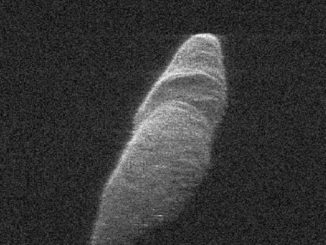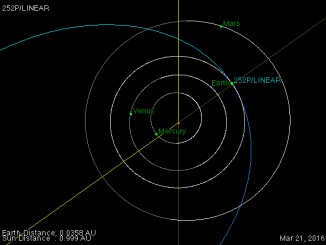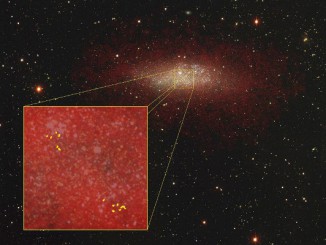
Lowell Observatory




Young star appears to be stripping away layers of close-orbiting ‘hot Jupiter’
Astronomers searching for the galaxy’s youngest planets have found compelling evidence for one unlike any other, a newborn “hot Jupiter” whose outer layers are being torn away by the star it orbits every 11 hours. Dubbed “PTFO8-8695 b,” the suspected planet orbits a star about 1,100 light-years from Earth and is at most twice the mass of Jupiter.

Astronomers find giant planet around very young star CI Tauri
Contradicting the long-standing idea that large Jupiter-mass planets take a minimum of 10 million years to form, astronomers have just announced the discovery of a giant planet in close orbit around a 2 million-year-old star that still retains a disc of circumstellar gas and dust. CI Tau b is at least eight times larger than Jupiter and 450 light-years from Earth.

A ‘tail’ of cometary twins buzzing Earth on 21-22 March
Comet 252P/LINEAR will zip past Earth on Monday, 21 March at a range of about 3.3 million miles. The following day, comet P/2016 BA14 will safely fly by our planet at a distance of about 2.2 million miles, or nine times the distance to the Moon. This will be the second closest flyby of a comet in recorded history next to comet D/1770 L1 (Lexell) in 1770.

The frozen canyons of Pluto’s north pole
This ethereal scene captured by NASA’s New Horizons spacecraft tells yet another story of Pluto’s diversity of geological and compositional features — this time in an enhanced colour image of the north polar area. A canyon about 45 miles wide runs close to the north pole, its degraded walls suggesting evidence for an ancient period of tectonics.

New Horizons returns full view of Pluto’s stunning crescent
In September, the New Horizons team released a stunning but incomplete image of Pluto’s crescent. Thanks to updated processing work by the science team, New Horizons is releasing the entire, breathtaking image of Pluto. The team also released images showing extended mapping of the dwarf planet’s “heart” feature and young craters on Pluto’s largest moon, Charon.

Historic Brashear telescope saved for restoration in NZ Dark Sky Reserve
A 125-year-old, 18-inch (46-cm) aperture Brashear refracting telescope with an illustrious history that has languished in storage for half a century has found a new Antipodean home. It marks the first step on the road to restoring the 7-ton, 8-metre-long instrument to its former glory, destined to become the centrepiece of a public outreach Astronomy Centre near the shore of Lake Tekapo in the heart of New Zealand’s South Island.

Dwarf galaxy WLM becomes star-forming powerhouse
Nearby dwarf galaxy Wolf—Lundmark—Melotte (WLM) poses an intriguing mystery: How is it able to form brilliant star clusters without the dusty, gas-rich environments found in larger galaxies? The answer, astronomers believe, lies in densely packed and previously unrecognised nuggets of star-forming material sprinkled throughout the galaxy.
